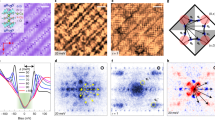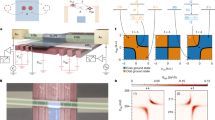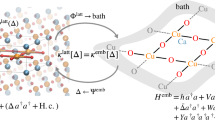Abstract
Carbon nanotubes (CNTs) are not intrinsically superconducting but they can carry a supercurrent when connected to superconducting electrodes1,2,3,4. This supercurrent is mainly transmitted by discrete entangled electron–hole states confined to the nanotube, called Andreev bound states (ABS). These states are a key concept in mesoscopic superconductivity as they provide a universal description of Josephson-like effects in quantum-coherent nanostructures (for example molecules, nanowires, magnetic or normal metallic layers) connected to superconducting leads5. We report here the first tunnelling spectroscopy of individually resolved ABS, in a nanotube–superconductor device. Analysing the evolution of the ABS spectrum with a gate voltage, we show that the ABS arise from the discrete electronic levels of the molecule and that they reveal detailed information about the energies of these levels, their relative spin orientation and the coupling to the leads. Such measurements hence constitute a powerful new spectroscopic technique capable of elucidating the electronic structure of CNT-based devices, including those with well-coupled leads. This is relevant for conventional applications (for example, superconducting or normal transistors, superconducting quantum interference devices3 (SQUIDs)) and quantum information processing (for example, entangled electron pair generation6,7, ABS-based qubits8). Finally, our device is a new type of d.c.-measurable SQUID.
This is a preview of subscription content, access via your institution
Access options
Subscribe to this journal
Receive 12 print issues and online access
$259.00 per year
only $21.58 per issue
Buy this article
- Purchase on SpringerLink
- Instant access to full article PDF
Prices may be subject to local taxes which are calculated during checkout




Similar content being viewed by others
Change history
17 November 2010
In the version of this Letter originally published online, there were several errors in Figure 1 and 'ϕ=(2e/h)Φ' should have read 'ϕ=(2e/ℏ)Φ' in the fourth paragraph of the text. These errors have now been corrected in all versions of the Letter.
References
Kasumov, A. Y. et al. Supercurrents through single-walled carbon nanotubes. Science 284, 1508–1511 (1999).
Jarillo-Herrero, P., van Dam, J. A. & Kouwenhoven, L. P. Quantum supercurrent transistors in carbon nanotubes. Nature 439, 953–956 (2006).
Cleuziou, J. P., Wernsdorfer, W., Bouchiat, V., Ondarcuhu, T. & Monthioux, M. Carbon nanotube superconducting quantum interference device. Nature Nanotechnol. 1, 53–59 (2006).
Pallecchi, E., Gaass, M., Ryndyk, D. A. & Strunk, C. Carbon nanotube Josephson junctions with Nb contacts. Appl. Phys. Lett. 93, 072501 (2008).
Beenakker, C. W. J. in Transport Phenomena in Mesoscopic Systems (eds Fukuyama, H. & Ando, T.) (Springer, 1992).
Recher, P., Sukhorukov, E. V. & Loss, D. Andreev tunneling, Coulomb blockade, and resonant transport of nonlocal spin-entangled electrons. Phys. Rev. B 63, 165314 (2001).
Herrmann, L. G. et al. Carbon nanotubes as Cooper-pair beam splitters. Phys. Rev. Lett. 104, 026801 (2010).
Zazunov, A., Shumeiko, V., Bratus’, E., Lantz, J. & Wendin, G. Andreev level qubit. Phys. Rev. Lett. 90, 087003 (2003).
Kulik, I. Macroscopic quantization and proximity effect in S–N–S junctions. Sov. Phys. JETP-USSR 30, 944–947 (1970).
Della Rocca, M. L. et al. Measurement of the current-phase relation of superconducting atomic contacts. Phys. Rev. Lett. 99, 127005 (2007).
Fischer, Ø., Kugler, M., Maggio-Aprile, I., Berthod, C. & Renner, C. Scanning tunneling spectroscopy of high-temperature superconductors. Rev. Mod. Phys. 79, 353–419 (2007).
Chen, Y., Dirks, T., Al-Zoubi, G., Birge, N. O. & Mason, N. Nonequilibrium tunneling spectroscopy in carbon nanotubes. Phys. Rev. Lett. 102, 036804 (2009).
Bockrath, M. et al. Luttinger-liquid behaviour in carbon nanotubes. Nature 397, 598–601 (1999).
Buitelaar, M. R., Nussbaumer, T. & Schönenberger, C. Quantum dot in the Kondo regime coupled to superconductors. Phys. Rev. Lett. 89, 256801 (2002).
Kuemmeth, F., Ilani, S., Ralph, D. C. & McEuen, P. L. Coupling of spin and orbital motion of electrons in carbon nanotubes. Nature 452, 448–452 (2008).
Glazman, L. I. & Matveev, K. A. Resonant Josephson current through Kondo impurities in a tunnel barrier. JETP Lett. 49, 659–662 (1989).
Spivak, B. I. & Kivelson, S. A. Negative local superfluid densities: The difference between dirty superconductors and dirty Bose liquids. Phys. Rev. B 43, 3740–3743 (1991).
Fazio, R., Hekking, F. W. J. & Odintsov, A. A. Josephson current through a Luttinger liquid. Phys. Rev. Lett. 74, 1843–1846 (1995).
Caux, J., Saleur, H. & Siano, F. Josephson current in Luttinger liquid-superconductor junctions. Phys. Rev. Lett. 88, 106402 (2002).
Dell’Anna, L., Zazunov, A., Egger, R. & Martin, T. Josephson current through a quantum dot with spin-orbit coupling. Phys. Rev. B 75, 085305 (2007).
Dolcini, F. & Dell’Anna, L. Multiple Andreev reflections in a quantum dot coupled to superconducting leads: Effect of spin–orbit coupling. Phys. Rev. B 78, 024518 (2008).
Zazunov, A., Egger, R., Jonckheere, T. & Martin, T. Anomalous Josephson current through a spin–orbit coupled quantum dot. Phys. Rev. Lett. 103, 147004 (2009).
Giazotto, F., Peltonen, J. T., Meschke, M. & Pekola, J. P. Superconducting quantum interference proximity transistor. Nature Phys. 6, 254–259 (2010).
Yoshioka, T. & Ohashi, Y. Numerical renormalization group studies on single impurity Anderson model in superconductivity: A unified treatment of magnetic, nonmagnetic impurities, and resonance scattering. J. Phys. Soc. Jpn 69, 1812–1823 (2000).
Vecino, E., Martı´n-Rodero, A. & Levy Yeyati, A. Josephson current through a correlated quantum level: Andreev states and pi junction behavior. Phys. Rev. B 68, 035105 (2003).
Meng, T., Florens, S. & Simon, P. Self-consistent description of Andreev bound states in Josephson quantum dot devices. Phys. Rev. B 79, 224521 (2009).
Deacon, R. S. et al. Tunneling spectroscopy of Andreev energy levels in a quantum dot coupled to a superconductor. Phys. Rev. Lett. 104, 076805 (2010).
Dirks, T. et al. Andreev bound state spectroscopy in a graphene quantum dot. Preprint at http://arxiv.org/abs/1005.2749 (2010).
Eichler, A. et al. Even–odd effect in Andreev transport through a carbon nanotube quantum dot. Phys. Rev. Lett. 99, 126602 (2007).
Grove-Rasmussen, K. et al. Superconductivity-enhanced bias spectroscopy in carbon nanotube quantum dots. Phys. Rev. B 79, 134518 (2009).
Acknowledgements
This work was partially supported by ANR project ANR-07-BLAN-0240 SEMAFAET, C’Nano project SPLONA and Spanish MICINN under contracts NAN2007-29366 and FIS2008-04209. The authors gratefully acknowledge discussions with the Quantronics group, O. Auslaender, J. C. Cuevas, R. Egger, M. Grifoni, T. Kontos, H. le Sueur, A. Martín-Rodero, P. Simon and C. Strunk.
Author information
Authors and Affiliations
Contributions
J-D.P. and C.Q.H.L. fabricated the sample. J-D.P., C.Q.H.L. and P.J. designed and carried out the experiment. J-D.P., C.Q.H.L., P.J., C.B. and A.L.Y. analysed the data and wrote the paper. P.M. provided the equipment for the nanotube synthesis.
Corresponding author
Ethics declarations
Competing interests
The authors declare no competing financial interests.
Supplementary information
Supplementary Information
Supplementary Information (PDF 996 kb)
Rights and permissions
About this article
Cite this article
Pillet, JD., Quay, C., Morfin, P. et al. Andreev bound states in supercurrent-carrying carbon nanotubes revealed. Nature Phys 6, 965–969 (2010). https://doi.org/10.1038/nphys1811
Received:
Accepted:
Published:
Issue date:
DOI: https://doi.org/10.1038/nphys1811
This article is cited by
-
Transport through a correlated polar side-coupled quantum dot transistor in the presence of a magnetic field and dissipation
Scientific Reports (2024)
-
Intermediate states in Andreev bound state fusion
Communications Physics (2023)
-
Microwave-induced conductance replicas in hybrid Josephson junctions without Floquet—Andreev states
Nature Communications (2023)
-
Phase-engineering the Andreev band structure of a three-terminal Josephson junction
Nature Communications (2023)
-
Phase-dependent Andreev molecules and superconducting gap closing in coherently-coupled Josephson junctions
Nature Communications (2023)



